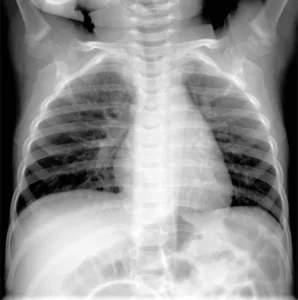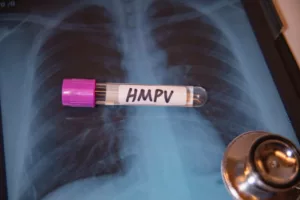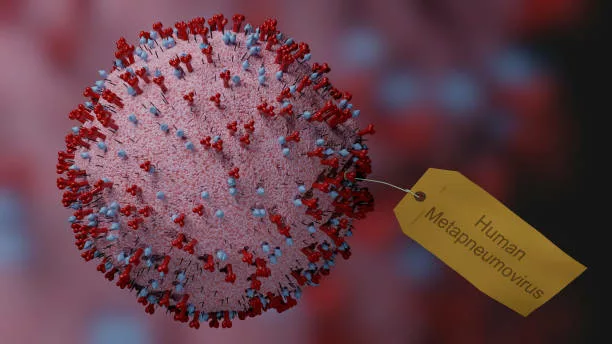Human Metapneumovirus (hMPV) is a pathogenic organism that targets your whole respiratory tract. This pathogen is more prevalent in the pediatric population but can also affect adults and immunodeficient individuals. It usually manifests flu symptoms or sometimes remains asymptomatic.1Panda S, Mohakud NK, Pena L, Kumar S. Human metapneumovirus: a review of an important respiratory pathogen. Int J Infect Dis. 2014 Aug;25:45-52.
This virulent pathogen was initially discovered in 2001 in the Netherlands. Initially, this virus belonged to the Paramyxoviridae family, but later, in 2016, it was reclassified and included in the Pneumoviridae family. Genetically, this virus has two groups: A and B. These groups are further categorized into subgroups such as A1, A2, B1, and B2, with year-to-year variation.2Vinci A, Lee PJ, Krilov LR. Human Metapneumovirus Infection. Pediatr Rev. 2018 Dec;39(12):623-624.
Prevalence
It has worldwide prevalence with varying incidence according to year and geographical location. The peak incidence of this virus occurs in temperate regions from February to April. The incidence of HMPV is generally lower than RSV. According to a seroprevalence study, 90-100% of children aged 5-10 years are affected by this pathogen.3Uddin, S. (2022, July 18). Human Metapneumovirus. StatPearls – NCBI Bookshelf. https://www.ncbi.nlm.nih.gov/books/NBK560910/
How do you get Human Metapneumovirus?
This virulent pathogen spreads from person to person through their respiratory droplets. The incubation period of metapneumovirus in your body is about 3-5 days and can vary between different individuals. This viral infection sometimes remains asymptomatic and recovers on its own within 10 to 12 days. After gaining entry into your body through respiratory droplets, this virus first affects your nasal mucosa and then moves down toward the respiratory tract (upper and lower).
Besides this, the metapneumovirus pathogen acts as an antigen in your body that induces an inflammatory response that causes an influx of monocytes and lymphocytes into your airway endothelium. In addition, these responses cause inflammation of your respiratory pathway, resulting in cough, sore throat, excess mucus production, and other respiratory manifestations that we will discuss later in this blog.
Risk Factors of Human Metapneumovirus
A healthy immune status can protect you from various diseases and fight well against them. Meanwhile, a weaker immune system increases the risk of getting a disease.
It most commonly affects children who have compromised immune systems.4Papenburg J, Hamelin MÈ, Ouhoummane N, Carbonneau J, Ouakki M, Raymond F, Robitaille L, Corbeil J, Caouette G, Frenette L, De Serres G, Boivin G. Comparison of risk factors for human metapneumovirus and respiratory syncytial virus disease severity in young children. J Infect Dis. 2012 Jul 15;206(2):178-89. doi: 10.1093/infdis/jis333. Epub 2012 May 2. PMID: 22551815; PMCID: PMC7114627. Moreover, it affects younger ones undergoing cancer treatment and people after organ transplant therapy because of immunosuppressant drugs. Other risk factors are:
- Pregnant Women
- Prematurity
- Steroid Abuse
- HIV
Symptoms of Human Metapneumovirus
Symptoms of metapneumovirus infection vary from person to person; some of them remain asymptomatic, while others are severely affected as this pathogen invades your whole respiratory tract (upper and lower), so it gives both upper and lower respiratory tract symptoms.5American Lung Association. (n.d.). *Human Metapneumovirus (hMPV) Symptoms and Diagnosis*. Retrieved from https://www.lung.org/lung-health-diseases/lung-disease-lookup/human-metapneumovirus-hmpv/symptoms-diagnosis
Upper Respiratory Tract Infection:
- Sore throat
- Nasal congestion
- Runny nose
- Cough
Lower Respiratory Tract Infection:
- Wheezing
- Fever
- Dyspnea (shortness of breath)
- Hypoxia
In children, this pathogen can cause bronchitis, bronchiolitis, croup, and pneumonia.6Biggs, H. M., Van Beneden, C. A., Kurkjian, K., Kobayashi, M., Peret, T. C. T., Watson, J. T., Schneider, E., Gerber, S. I., & Ravishankar, J. (2020). Severe Human Metapneumovirus and Group A Streptococcus Pneumonia in an Immunocompetent Adult. Clinical infectious diseases: an official publication of the Infectious Diseases Society of America, 70(12), 2712–2714. https://doi.org/10.1093/cid/ciz961 Moreover, it also flares up the symptoms of ongoing respiratory illnesses such as asthma, COPD, pneumonia, and bronchitis in adults.
Gastrointestinal Manifestation of Human Metapneumovirus
This virus may also affect the gastrointestinal tract of affected individuals. Gastrointestinal manifestations include:7Barrera-Badillo, G., Olivares-Flores, B., Ruiz-López, A., Fierro-Valdez, M. Á., Gutiérrez-Vargas, R. I., & López-Martínez, I. (2020). Human Metapneumovirus: Etiological Agent of Severe Acute Respiratory Infections in Hospitalized and Deceased Patients with a Negative Diagnosis of Influenza. Pathogens (Basel, Switzerland), 9(2), 85. https://doi.org/10.3390/pathogens9020085
- Vomiting
- Diarrhea
- Nausea
Is Human Metapneumovirus Contagious?
Yes, this virus is extremely contagious as it spreads from person to person through:8Centers for Disease Control and Prevention. (2023). *Human Metapneumovirus (hMPV) – About hMPV*. Retrieved from https://www.cdc.gov/human-metapneumovirus/about/index.html
- Respiratory droplets during sneezing, coughing, or through nasal secretions
- Shaking hands with an infected person
- Touching or using the object of an infected person
Diagnosis of Human Metapneumovirus
Some individuals remain asymptomatic and recover on their own without taking any medical interventions. Investigations are advised in patients with serious illnesses or other comorbidities. In addition, diagnosis of this viral infection starts with a detailed history, physical examination, laboratory studies, and radiological studies.9Bever, L. (2023, May 30). What is human metapneumovirus? Washington Post. https://www.washingtonpost.com/wellness/2023/05/30/human-metapneumovirus-hmpv-symptoms/#D5NPPCYYCBHXZEVUHJAR63COWE-3
History:
A proper and detailed history is the mainstay of investigation when diagnosing any disease. Your doctor may ask the following questions:
- Do you have a fever or chills? Onset and duration of fever?
- Do you have nasal congestion?
- Do you feel shortness of breath? Any relieving or aggravating factor?
- Any previous illness?
- Any previous treatment history?
Physical Examination:
Finally, after taking the history, your doctor will perform a thorough physical examination to support his diagnosis. Physical examination includes the following steps:
- Examination of the nose and throat
- Examination of the lips and fingers of the patients to check for hypoxia
- Lymph nodes examination
- Chest and abdominal examination
Laboratory Examination:
A few laboratory investigations help with the diagnosis of metapneumovirus infection. Laboratory investigations include:
- Complete Blood count (CBC)
- IgE levels
- Nasal swab testing
- ELISA
Imaging Studies:
Imaging studies are advised to confirm the diagnosis. These studies include radiographic studies like chest X-rays and CT scans.
Radiographic Study:
Radiographic studies (chest X-ray and CT scan) are initial tests to diagnose metapneumovirus. The findings on the x-ray remain unspecified unless human metapneumovirus causes bronchitis or pneumonia. Radiological findings include:
- Lobar infiltrates
- Hyperinflation of lungs
- Teri bronchial buffing
- Opacities in lungs

X-ray of a 19-month-old child with HMPV
Polymerase Chain Reaction (PCR):
Reverse transcriptase polymerase chain reaction (RT-PCR) of the nasal swab. PCR is an investigation of choice for metapneumovirus infection.

Bronchoscopy:
Bronchoscopy is advised in the most severe cases. Your doctor will insert a camera-guided flexible bronchoscope from your throat into your lungs and take a fluid sample. This sample helps with the diagnosis of metapneumovirus.
Treatment of Human Metapneumovirus
The primary treatment for metapneumovirus infection is supportive and symptomatic. Antipyretic medications like paracetamol relieve fever. In case of high-grade fever, sponging is also advised before giving antipyretics. Additionally, nasal decongestants relieve nasal congestion.
Moreover, if the patient is dehydrated and unable to feed orally, intravenous hydration is advised in these patients with normal saline or ringer lactate solution. If the patient can feed orally, then oral rehydration is enough.
Patients with dyspnea (difficulty breathing) may require oxygen support. In more severe cases, mechanical ventilation is required.
There is no specific vaccine for this virus, so preventive measures are necessary to prevent further spread.
Prevention of Human Metapneumovirus
As there is no specific treatment for this metapneumovirus infection, following preventive measures prevent the further spread of this virus. These preventative measures are:
- Patient and family education
- Healthy diet
- Cover your nose during coughing and sneezing
- Quarantine yourself until you feel yourself symptoms free
- Avoid handshaking with others
- Don’t share your glass with other family members
- Wash your hands frequently
Complications of Human Metapneumovirus
This virus rarely causes complications in asymptomatic patients, but it can be fatal in patients with immunocompromised status. Comparatively, it is usually less fatal than other respiratory pathogens. In some individuals, this virus can cause :
Bronchitis:
It is the inflammation of your bronchi (bronchi are the air tubules in your lungs). It can occur in all ages.
Bronchiolitis:
It is the inflammation of your bronchioles. It usually affects children below two years of age.
Pneumonia:
It is an infectious disease that affects the air sacs (alveoli). It produces cough-like symptoms, fever, flu or runny nose, and fatigue. Moreover, in severe cases, it causes consolidation of the lungs.
Acute Respiratory Failure:
In immunocompromised patients, this virus can be fatal and cause acute respiratory shutdown. So, these patients require urgent hospitalization.
The Human Metapneumovirus Mortality Rate:
The human metapneumovirus can cause severe illness in immunocompromised patients and people with other comorbidities. According to a report, the overall mortality rate of human metapneumovirus pneumonia is about 22%.10Shehu MT, Pascual A, Kapinos P, El Khoury MY. Mortality and Morbidity of Human Metapneumovirus Infection in the Pre-COVID-19 Era: The Value of the Charlson Comorbidity Index on Outcome Prediction. Cureus. 2024 Jan 15;16(1):e52321. doi: 10.7759/cureus.52321. PMID: 38357041; PMCID: PMC10866625.
How does HMPV differ from RSV?
RSV (Respiratory Syncytial Virus) and HMPV (Human Metapneumovirus) share similar symptoms, but it’s important to note that they are distinct viruses. HMPV typically affects older infants, specifically those aged between 6 to 12 months, whereas RSV primarily affects younger infants under the age of 6 months. Additionally, RSV infection rates are generally higher than those of HMPV. Furthermore, both viruses exhibit almost identical seasonal epidemiology.11MSD Manuals. (n.d.). Respiratory Syncytial Virus (RSV) Infection and Human Metapneumovirus Infection. Retrieved from https://www.msdmanuals.com/home/children-s-health-issues/respiratory-disorders-in-infants-and-children/respiratory-syncytial-virus-rsv-infection-and-human-metapneumovirus-infection
Conclusion
In conclusion, human metapneumovirus is the most prevalent viral pathogen that affects your respiratory pathway. It predominantly affects children below two years of age. Clinically, it is characterized by rhinorrhea (runny nose), sore throat, and chills. Some people remain symptom-free but can spread this infection via respiratory droplets. It can cause serious illness in immunocompromised patients. Moreover, there is no specific treatment or vaccine for this viral infection; some individuals recover on their own within 10-12 days. Supportive and preventive measures help ameliorate the symptoms of this infection.
Refrences
- 1Panda S, Mohakud NK, Pena L, Kumar S. Human metapneumovirus: a review of an important respiratory pathogen. Int J Infect Dis. 2014 Aug;25:45-52.
- 2Vinci A, Lee PJ, Krilov LR. Human Metapneumovirus Infection. Pediatr Rev. 2018 Dec;39(12):623-624.
- 3Uddin, S. (2022, July 18). Human Metapneumovirus. StatPearls – NCBI Bookshelf. https://www.ncbi.nlm.nih.gov/books/NBK560910/
- 4Papenburg J, Hamelin MÈ, Ouhoummane N, Carbonneau J, Ouakki M, Raymond F, Robitaille L, Corbeil J, Caouette G, Frenette L, De Serres G, Boivin G. Comparison of risk factors for human metapneumovirus and respiratory syncytial virus disease severity in young children. J Infect Dis. 2012 Jul 15;206(2):178-89. doi: 10.1093/infdis/jis333. Epub 2012 May 2. PMID: 22551815; PMCID: PMC7114627.
- 5American Lung Association. (n.d.). *Human Metapneumovirus (hMPV) Symptoms and Diagnosis*. Retrieved from https://www.lung.org/lung-health-diseases/lung-disease-lookup/human-metapneumovirus-hmpv/symptoms-diagnosis
- 6Biggs, H. M., Van Beneden, C. A., Kurkjian, K., Kobayashi, M., Peret, T. C. T., Watson, J. T., Schneider, E., Gerber, S. I., & Ravishankar, J. (2020). Severe Human Metapneumovirus and Group A Streptococcus Pneumonia in an Immunocompetent Adult. Clinical infectious diseases: an official publication of the Infectious Diseases Society of America, 70(12), 2712–2714. https://doi.org/10.1093/cid/ciz961
- 7Barrera-Badillo, G., Olivares-Flores, B., Ruiz-López, A., Fierro-Valdez, M. Á., Gutiérrez-Vargas, R. I., & López-Martínez, I. (2020). Human Metapneumovirus: Etiological Agent of Severe Acute Respiratory Infections in Hospitalized and Deceased Patients with a Negative Diagnosis of Influenza. Pathogens (Basel, Switzerland), 9(2), 85. https://doi.org/10.3390/pathogens9020085
- 8Centers for Disease Control and Prevention. (2023). *Human Metapneumovirus (hMPV) – About hMPV*. Retrieved from https://www.cdc.gov/human-metapneumovirus/about/index.html
- 9Bever, L. (2023, May 30). What is human metapneumovirus? Washington Post. https://www.washingtonpost.com/wellness/2023/05/30/human-metapneumovirus-hmpv-symptoms/#D5NPPCYYCBHXZEVUHJAR63COWE-3
- 10Shehu MT, Pascual A, Kapinos P, El Khoury MY. Mortality and Morbidity of Human Metapneumovirus Infection in the Pre-COVID-19 Era: The Value of the Charlson Comorbidity Index on Outcome Prediction. Cureus. 2024 Jan 15;16(1):e52321. doi: 10.7759/cureus.52321. PMID: 38357041; PMCID: PMC10866625.
- 11MSD Manuals. (n.d.). Respiratory Syncytial Virus (RSV) Infection and Human Metapneumovirus Infection. Retrieved from https://www.msdmanuals.com/home/children-s-health-issues/respiratory-disorders-in-infants-and-children/respiratory-syncytial-virus-rsv-infection-and-human-metapneumovirus-infection





